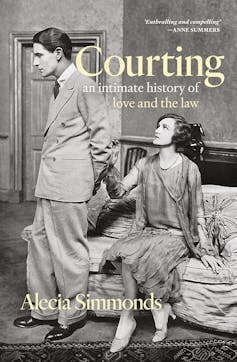
Just a few lines to my ever dear Beattie.
My dear love. I am nearly mad.
Dear love, I love the ground you walk upon.
My dear love. I pity you from the bottom of my heart.
You are my love for life.
I think it is a yarn about my wife being alive … I think it is spite …
Dear, I would like to see you …
On a squally autumn day in Sydney in March 1914, Beatrice Storey, a barmaid, sued Frederick Chapman, a farmer, for abandoning her on the day of their wedding. To be precise, she claimed £1,000 damages in the New South Wales Supreme Court for breach of promise of marriage, a suit that could be used to claim compensation for injuries arising from a broken engagement.
Beatrice had first glimpsed Frederick a year earlier, from behind the bar at the Captain Cook Hotel. Cavalier, stocky and a “spinner of yarns”, he breezed into the pub “smelling of horses and flashing his winnings”. He told her he had been at the Moore Park races down the road. He also said he was 40, wealthy and a widower. After a month of giddy infatuation, he presented her with a wedding ring and vowed he would marry her.
Almost none of what he told her was true.
Beatrice explained from the witness box to the judge and a jury of four that she was 30 years old when she quit her employment, on Frederick’s insistence, and moved back home with her mother a few doors down on Flinders Street. Yes, she and Frederick had made wedding arrangements at St Barnabas’ church on George Street: 40 invitations were sent out; the wedding cake and carriage were ordered.
She had selected furniture for their new home in Kensington, and he had promised to settle the property upon her as well as gifting her £2,000 to furnish the house. “He said he had plenty of money,” she informed the court; “in fact, ‘money to burn’.” The day before the wedding, Frederick kissed Beatrice goodbye on the porch of her brother’s house and told her not to be late for church.
Frederick never showed up for his wedding. He phoned Beatrice and apologised, asking her to cancel the ceremony as he had just received news his wife was alive. The marriage would make him a bigamist.
Read more: Friday essay: 3 ways philosophy can help us understand love
Beatrice was livid. Frederick rushed to her house and tried to console her, begging her to take the wedding ring, fumbling his way into an embrace, chaotically trying to kiss her. She pushed him away. In the following weeks Frederick turned to ink and paper, bewailing the maddening effects of passion, confessing that the reports of his wife were “a yarn” and exhorting that it was his “greatest wish to marry”.

Beatrice converted Frederick’s love letters into legal evidence and his passion into proof, in one of the most lucrative breach of promise actions of her decade: £350 compensation for her “lacerated feelings”.
The next time Beatrice and Frederick appear on the historical record is on January 23 1915, at St Martin’s Anglican Church in Kensington. This time, Frederick showed up for his wedding.
A little under 60 years later, in the early 1970s, a grandson of Beatrice and Frederick was also sued for breach of promise of marriage, just before the action was abolished. No newspaper bothered to report it, and we only know of the action because in 1986 a Liberal politician, Wilson Tuckey, raised it in federal parliament.
“Paul had a girl called Christine,” he hissed, directing his comments at a Labor MP named Paul, also implying (incorrectly) that an illegitimate child had been born.
“Madame Speaker,” the Labor MP interjected. He demanded Tuckey be censured. He railed against him, calling him a criminal. Later that day, the Labor MP held a press conference outside Parliament House to address the remarks and asked that they be erased from the Hansard minutes. This Labor MP, the grandson of Beatrice and Frederick, was the future prime minister Paul Keating.
Servants, seamstresses, nurses
Why would Keating care so much about a past breach of promise suit – an action that by the 1970s was seen as a quirky relic from the Victorian era? Why should we care about his breach of promise suit, or any action over a thwarted romance in the past? What can the minor tragedies we see in breach of promise cases tell us about the history of love in Australia over the course of two centuries? And what might they suggest about how humans have sought to govern love – the most ungovernable of emotions, across time?
I have spent the past ten years looking for love in the canons of law; digging up around 1,000 breach of promise cases in search of answers to these questions. In the process, I have encountered a different kind of protagonist to those I have been accustomed to meeting in histories of romantic love. Here there are no lofty philosophers, sensitive poets or delicate letter-writers penning epistles in the hush of a lady’s drawing room.
The feckless Lotharios are shearers, train drivers, bankrupt shopkeepers, farmers and commercial travellers. Their scorned brides are people like Beatrice Storey: barmaids, domestic servants, seamstresses, nurses, piano teachers and, later in the century, chorus girls and migrants. They are mostly ordinary people of the lower-middle orders who could not afford the luxury of privacy, nor the indulgence of marrying for love alone.
Some went to court seeking compensation for lost wages or diminished social and economic status, others for wounded affections or missed romantic opportunities, and many more, like Beatrice, were using the action to pressure their partner to marry them.
Women who had been “seduced” litigated to defend their sexual reputations. Most plaintiffs were refreshingly oblivious or indifferent to the social scorn that the legal action cast upon them: the indignity of having your most private feelings filleted before a public audience; the perceived vulgarity of seeking financial recompense for the unquantifiable pain of a broken heart.
Contemporary fantasies of romantic plenitude
If Beatrice Storey had been left at the altar today, Frederick Chapman would not have been forced by the state to compensate her for her hurt feelings, nor for any financial losses she incurred. The fact Fred was an intimate partner, rather than a commercial one, would likely have denied her a legal remedy.
The law tends to assume that intimates don’t intend to create legal relations. Women are not economically and socially dependent on marriage as they once were, and a failed relationship does not relegate women to the status of damaged goods. Courtship is now defined by love, choice, physical desire and mutual negotiation, rather than by contractual legal obligation.
Fuelled by dating apps that promise a new partner by simply swiping right on your phone, fantasies of romantic plenitude have replaced legal regimes of punishment.
Yet people continue to experience injury, be it financial, emotional or bodily, when intimate promises are broken, and the discovery of deceit in relationships can be life-altering.
Read more: 3 in 4 people experience abuse on dating apps. How do we balance prevention with policing?
Rather than seeing the unmooring of love from law as a tale of liberation, by which love was set free from the paternalistic bonds of the state, I question what we have lost in this process, and how we might imagine, legally and socially, an ethics of intimacy.

Instead of turning to law, the Beatrice Storey of today would likely try to overcome her pain by reading self-help books or talking to friends, family and experts, all educated to varying degrees in psychology. The advice she would receive would no doubt revolve around the virtues of resilience, the balm of commodity culture (go out and buy yourself a new dress!), and interrogation of her own psyche (why had she been attracted to such a duplicitous cad in the first place?).
Where law would have ascribed fault and demanded a tallying-up of emotional, bodily and financial harm that could be compensated (however awkwardly) by money, therapeutic discourse is uninterested in material loss or ethical responsibility.
What was once a public debate about the rules of romance, including its gendered financial costs and the seriousness of its injuries, is now sequestered in the therapist’s clinic.
Like scholars before me, I argue that the “coming of the counsellors” by the mid-20th century was not a victory but a loss, particularly for women. Responsibility for romantic injury has been individualised and feminised, and its pain trivialised, drained of economic meaning.
High stakes
There is something fundamentally human about falling in love that allows us to feel the amorous tremors of love poetry such as Sappho or Byron although centuries may yawn between us and the poet. But love is also not just love. When we see doctors giving testimony about the medical effects of heartbreak, or read of Beatrice Storey turning around after her court case and marrying Frederick Chapman, or applaud women at the start of the 20th century for claiming damages for the dinners they had cooked their lovers, we know we are dealing with an emotion that is profoundly shaped by culture. Love is a creature of its time. And it is in the space between strangeness and familiarity that the history of love can be found.
When I tell my students they could once have sued a lover for breaking an engagement, they are always astonished and a bit indignant; romance is not a fit subject for law, they say. Their response exposes a cultural assumption that love and law are opposites, conceptual antipodes, each untranslatable and hostile to the other. We think of romance as frolicsome, rebellious, impetuous and wilful, impervious to the monolithic sobriety of law.

From the ancients to the romantic poets, love has been a breaker of rules, which is why social contract theorists such as Jean-Jacques Rousseau viewed it with suspicion. “Lovers never see anyone but themselves, they incessantly attend only to themselves and the only thing they are able to do is love each other,” he complained.
While law is rational and generalisable, love is a divine delirium that makes little sense to anyone but the couple afflicted.
Read more: Explainer: the philosophy of Jean-Jacques Rousseau is profoundly contemporary
Ethical or not, today’s courting couples can “ghost” away without consequence; they can break promises or refrain from making them at all. Being true to your own feelings and following your own desires now trumps any notion of duty or honour. Ineffable, exquisitely personal, secretive and mysterious, romantic love, as we imagine it, has nothing to do with the coercive, transparent machinations of our public legal system.
But if we think more deeply, this easy dichotomy between love and law begins to break down. Love has its own laws and exercises its own jurisdiction; like law, it demands, either pleasurably or punitively, that we relinquish our will to a higher order. Love may elevate us – magically transfiguring the world into something as beautiful as our imagined love object – but like law it can also deprive us of autonomy, bestow obligations, punish transgressions and issue commands.
And because the stakes in love and law are high, as both change lives, they have a similar interest in evidence: “How do I know you are who you say you are?” and “can I place trust in your words?” are questions asked as anxiously in court as in courtship.
Love and law propel us on a quest for proof: we hunt for clues in small gestures, we read signs into bodily disturbances, we discern meaning in happenstance and we detect broad patterns of significance in the minutiae of everyday life.
An ethics of love?
Over the course of two centuries, romantic love and law become separated. Each declares incompetency in the realm of the other, and I wonder whether this is something we should celebrate.
Is there such a thing as an ethics of love? What did we lose in the shift from the legal condemnation of deceit in relationships to psychological exhortations to resilience? Should we take romantic injuries more seriously? How should we economically value intimate labour?
History is not simply about avoiding the mistakes of the past – for we never do this anyway. It is at best an exercise in humility: learning that humans are malleable creatures and that the various incarnations of humanity we meet when we travel back in time may sometimes be wiser creatures than ourselves.
For Australians, a history of love told from the papery relics of one of our most treasured national icons – the working-class battler – is a corrective to traditional histories of love that tend to favour the bourgeoisie, and an antidote to our anaemic national mythologising of stoic, independent blokes and robust women.
Frederick Chapman may have been a stockman, larrikin and “spinner of yarns”, but he was also nervous, sentimental and smitten by Beatrice Storey. And far from being a long-suffering heroine of Australian legend, Beatrice took her squandered affections to court and won.
Writing a history of courtship from the archival remains of broken hearts allows us to tell national and transnational stories of vulnerability and resistance, of fierce and fragile inner worlds.
This is an edited extract from Courting: an intimate history of love and the law by Alecia Simmonds (Black Inc).
Alecia Simmonds received funding from The State Library of New South Wales where she was a Merewether Fellow.
This article was originally published on The Conversation. Read the original article.







